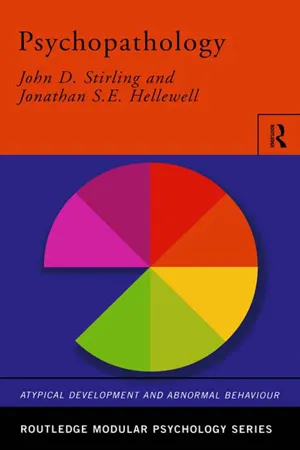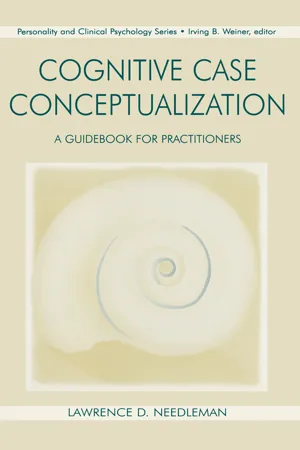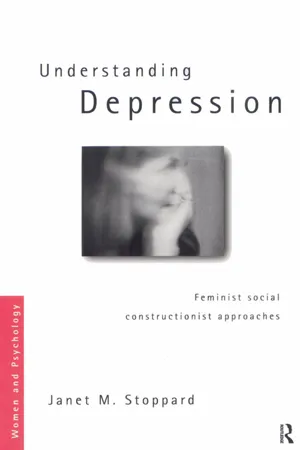Depressive Disorder
Depressive disorder is a mental health condition characterized by persistent feelings of sadness, hopelessness, and a loss of interest in activities. It can significantly impact a person's daily functioning and quality of life. Symptoms may include changes in appetite, sleep disturbances, fatigue, and difficulty concentrating. Treatment often involves a combination of therapy and medication.
8 Key excerpts on "Depressive Disorder"
- eBook - ePub
- Constance Hammen, Ed Watkins(Authors)
- 2018(Publication Date)
- Routledge(Publisher)
...It is enormously impairing – and even deadly – and its effects on both the afflicted person and his or her family can be profoundly negative. Yet, we also have a number of effective treatments for depression and science is gaining considerable insight into the processes underpinning depression. Phenomenology of depressive experiences The term depression is used in everyday language to describe a range of experiences from a slightly noticeable and temporary mood decrease to a profoundly impaired and even life-threatening disorder. When used to describe a mood, the term conveys a temporary state of sadness and loss of energy or motivation that may last a few moments, hours, or even a few days. As such, it is usually a normal reaction to an upsetting event, or even an exaggerated description of a typical event (‘this weather is depressing’). A young man might feel sad for a few days following a romantic disappointment, or a woman might be discouraged for a few days upon being passed over for a job. Such experiences are not the topic of this book. Rather, the term ‘depression’ as used here refers to a constellation of experiences including not only mood, but also physical, mental and behavioural experiences that define more prolonged, impairing and severe conditions that may be clinically diagnosable as a syndrome of depression. The description at the beginning of the chapter may differ from the personal experiences of other depressed people, but all share features of the syndromes of depression. Each sufferer has features from the four different domains that define Depressive Disorders. The four general domains are affect, cognition, behaviour and physical functioning. Affective symptoms Depression is one of several disorders generically called affective disorders, referring to the manifestations of abnormal affect or mood, as a defining feature. Thus, depressed mood, sadness, feeling low, down in the dumps or empty are typical...
- Jessica Kuper, Jessica Kuper(Authors)
- 2015(Publication Date)
- Routledge(Publisher)
...Depressive Disorders DOI: 10.4324/9781315677101-43 Depressive Disorders are a heterogeneous group of conditions that share the common symptom of dysphoric mood. Current psychiatric classification divides major Depressive Disorders into bipolar and non-bipolar categories, depending on whether there is evidence of associated manic episodes. Less severe depressive states are categorized as dysthymic, cyclothymic, and atypical Depressive Disorders. The diagnosis of a Depressive Disorder is made only when the intensity and duration of depressive symptoms exceed those usually provoked by the stresses of normal life. Major depressive episodes are characterized by a pervasive dysphoric mood, which may be associated with feelings of worthlessness, suicidal ideation, difficulty with concentration, inability to feel pleasure, and neurovegetative changes in appetite, sleep patterns, psychomotor activity and energy levels. In severe cases, psychotic symptoms such as hallucinations and delusions with evident depressive themes may also be present. Dysthymic disorders are conceptualized as chronic, non-psychotic conditions, of at least two years’ duration, with similar symptomatology but of lesser intensity. Cyclothymic disorders involve alternating periods of dysthymic and mildly manic moods. Depressive conditions that do not clearly fit into any of these categories are designated as atypical. Current classificatory tendencies are to group Depressive Disorders on the basis of their phenomonology, thus eschewing conclusions as to aetiology. Nonetheless, many experts continue to find value in differentiating between endogenous (or autonomous) and reactive, or psychotic and neurotic, conditions. However defined, the prevalence of Depressive Disorders is relatively high; most estimates are in the range of 7 per cent of the population suffering from a diagnosable depression each year...
- eBook - ePub
- John Stirling, Jonathan Hellewell(Authors)
- 2013(Publication Date)
- Routledge(Publisher)
...5 The nature of affective disorders Introduction Depression Major depressive illness: the clinical picture Minor depressive states: the clinical picture Mood disorders associated with childbirth Mania: the clinical picture Epidemiology of the affective disorders Treatment Prognosis Summary Introduction Most people will be aware of a day-to-day variation in their mood and that of the people around them. You might have experienced short periods of feeling miserable, perhaps at times of stress or personal disappointment, or a few days of elation following particularly good news such as success in examinations. The broader term affect is used to describe not just the subjective aspects of mood, but also to include features that are evident to the external observer, such as the person's behaviour and speech. Therefore mood or affective disorders are characterised by disturbances of affect, in the directions of depression or elation. These illnesses are distinguished from the normal variation in mood on the basis of two criteria: (a) Degree of disturbance. There is a profound disturbance in mood, in either the direction of depression or elation, which is out of proportion with the circumstances. (b) Duration. The changes persist for weeks—or even months—and appear largely unresponsive to changes in situation. Depression The central feature of the depressive illness is a persistent lowering of mood, although many other symptoms may also be present. Sufferers may have disorders of thinking, attention and concentration, feelings of anxiety and disturbances in sleep and appetite. Over the years, a variety of terms have been used to describe different aspects of the depressive illness. Depression which seems to follow an obvious stressor, such as redundancy or bereavement, is sometimes described as reactive. In contrast, the term endogenous, which literally means ‘arising from within’ is used to describe illnesses which do not appear to be related to stressful events...
- eBook - ePub
Cognitive Case Conceptualization
A Guidebook for Practitioners
- Lawrence D. Needleman(Author)
- 1999(Publication Date)
- Routledge(Publisher)
...Factors that are likely to maintain depression include social skills deficits (see Lewinsohn & Gotlib, 1995) as well as deficits in the ability to maintain rewarding intimate relationships (Klerman et al., 1984). Moreover, several cognitive factors appear to render individuals vulnerable to depression or maintain depression in affected individuals (discussed later). According to the DSM–IV (APA, 1994), a major depressive episode is characterized by at least 2 weeks in which the individual experiences a depressed mood and/or diminished interest or pleasure in almost all activities most of the day nearly every day. Besides having a depressed mood and/or diminished interest, the individual must have at least 5 out of a list of 9 other depressive symptoms during the episode. The other symptoms are (a) significant changes in weight or appetite; (b) frequent insomnia or hypersomnia; (c) psychomotor agitation or retardation; (d) fatigue or loss of energy; (e) feelings of worthlessness or excessive or inappropriate guilt; (f) diminished ability to think, concentrate, or make decisions; and (g) recurrent thoughts of death or suicide. The symptoms must cause clinically significant distress or impairment in functioning. In addition, the individual must never have experienced a manic episode, a mixed (depressed and manic) episode, or a hypomanic episode. The symptoms are not due to the direct physiological effects of a substance or a general medical condition and are not better accounted for by normal bereavement. Finally, a major Depressive Disorder consists of the presence of a major depressive episode that is not better accounted for by a psychotic disorder. (When psychotic symptoms are present only during a depressed episode, the episode is coded as a major depressive episode with psychotic features). Cognitive Model of Depression Figure 8.1 illustrates the cognitive model of depression with Sammy, a college student who had recurrent major depression...
- Amy E. Wenzel(Author)
- 2017(Publication Date)
- SAGE Publications, Inc(Publisher)
...Casey E. Allington Casey E. Allington Allington, Casey E. Carolyn M. Pepper Carolyn M. Pepper Pepper, Carolyn M. Depressive Disorders: Psychological Factors Depressive Disorders: Psychological Factors 1053 1057 Depressive Disorders: Psychological Factors Depressive Disorders are a category of conditions listed in the American Psychiatric Association’s Diagnostic and Statistical Manual of Mental Disorders, Fifth Edition (DSM-5), that have common features of sad, empty, or irritable mood; somatic and cognitive changes; and significant, functional impairment in daily life. The disorders that fall under the Depressive Disorder category are major Depressive Disorder, persistent Depressive Disorder, disruptive mood dysregulation disorder, premenstrual dysphoric disorder, substance/medication-induced Depressive Disorder, Depressive Disorder due to another medical condition, other specified Depressive Disorder, and unspecified Depressive Disorder. These diagnoses differ in duration, timing of onset, and potential causal factors. Psychological factors represent a common link across disorders that contribute to the onset and maintenance of Depressive Disorders. Often, multiple psychological factors are present in Depressive Disorders, and they may work together in complex ways. There are a wide range of concepts that make up psychological factors, including stressful life events; cognitive factors such as attention, thoughts, and memory; behavioral factors; and personality. These processes are related to one another and can influence how other factors affect the development and maintenance of Depressive Disorders. For example, a negative stressful life event, such as a job loss, does not lead to a Depressive Disorder for most individuals. However, a job loss is more likely to lead to a Depressive Disorder if the individual has a neurotic personality style, focuses his or her attention on ruminating about the event, and avoids searching for a new job for fear of rejection...
- Katie M. Sandberg, Taryn E. Richards, Bradley T. Erford(Authors)
- 2013(Publication Date)
- Routledge(Publisher)
...C HAPTER 3 Assessment of Mood Disorders P RIMARY M OOD D ISORDERS C OMMONLY ENCOUNTERED IN CLINICAL P RACTICE Mood disorders are commonly experienced in children, adolescents, and adults, and cause significant impairments in life functioning. The most recent edition of the Diagnostic and Statistical Manual of Mental Disorders (DSM-5 ; APA, 2013) has separated mood disorders into two categories: Depressive Disorders, and bipolar and related disorders. The most commonly encountered mood disorders include major Depressive Disorder (single and recurrent episodes), chronic Depressive Disorder (previously dysthymia), bipolar disorders I and II, and cyclothymic disorder. Other disorders include disruptive mood dysregulation, premenstrual dysphoric, mixed anxiety/depression, substance-induced depressive, and substance-induced bipolar. Major Depressive Disorder may include a single episode or recurrent episodes. A major depressive episode occurs during a two-week period in which the individual experiences symptoms related to either depressed mood or loss of interest or pleasure. The individual must exhibit five or more of the following symptoms: (a) depressed mood throughout the day; (b) decreased pleasure or interest in daily activities; (c) significant weight loss or gain; (d) restlessness or oversleeping; (e) visible psycho-motor distress; (f) noticeable decrease in vigor; (g) sense of worthlessness or incongruous guilt; (h) trouble focusing; or (i) fixation with death, suicidal thoughts with or without a plan, or suicidal attempt (APA, 2013). A diagnosis of major Depressive Disorder (single episode) is characterized by: (a) the occurrence of one major depressive episode; (b) the episode is not best accounted for by another disorder; and (c) absence of a history of a manic or hypomanic episode. The clinician should specify the current status of the disorder as mild, moderate, or severe, and whether the presence of mood congruent or incongruent psychotic symptoms exists...
- eBook - ePub
Understanding Depression
Feminist Social Constructionist Approaches
- Janet Stoppard(Author)
- 2014(Publication Date)
- Routledge(Publisher)
...For instance, the diagnostic criteria for Depressive Disorder (“Major Depressive Disorder”) used by professionals in North America, and increasingly in many other parts of the world (cf. Culbertson 1997), were developed by the American Psychiatric Association (APA). These criteria are published in the Diagnostic and Statistical Manual of Mental Disorders [DSM] (APA 1994), and those listed in the recent (fourth) edition of the DSM for the main type of Depressive Disorder are shown in Table 1. In essence, the diagnostic criteria for Depressive Disorder consist of a list of subjective and bodily experiences. These experiences, termed symptoms, need to have been “present during the same two-week period” and to “represent a change from previous functioning” (see Table 1) to make a diagnosis of Depressive Disorder. An individual’s symptoms can meet the DSM criteria in a variety of ways, provided that at least one of the first two in the list (see Table 1) is present. These two symptoms are “depressed mood most of the day, nearly every day” and, “markedly diminished interest or pleasure in all, or almost all, activities most of the day, nearly every day”. There are seven additional symptoms (see Table 1), with at least four needing to be present before a diagnosis of Depressive Disorder is made. Diagnostic criteria for Depressive Disorder: format and content Several observations can be made about the format and content of the diagnostic criteria for Depressive Disorder given in the DSM. First, the criteria are formatted in a precise way, with clear directions for diagnostic decision-making (e.g. “Five [or more] of the following symptoms have been present”). Also, the form in which the criteria are presented, and their impersonal phrasing (there is no mention of the person being assessed), help to create an impression of detached scientific objectivity...
- eBook - ePub
ADHDAttention Deficit Hyperactivity Disorder
A Tutorial Study Guide
- Nicoladie Tam(Author)
- 2015(Publication Date)
- Nicoladie Tam, Ph.D.(Publisher)
...Affective Disorders: Depression, Mania and Bipolar Disorder Objectives: Understand the different affective disorders Concepts to Learn Unipolar disorder Bipolar disorder Mania *~*~*~*~* 1.1.Depression Objectives: Understand the different affective disorders Concepts to Learn Definition of depression Unipolar disorder Dysphoric moods of depression Symptoms of depression Seasonal affective disorder (SAD) Treatment of SAD Suicidal risks *~*~*~*~* Q&A What are the essential features of depression? The characteristics features of depression are: Depressed mood or Loss of interest or pleasure in nearly all activities that last more than two weeks. Depression can be normal if it does not interfere with daily functioning, and if it does not last for a long duration. Depression is a natural response to the loss of anything that is considered as valuable, such as loss of loved ones, loss of possession and loss of achieved goals. The depressive episodes often recur in major depression throughout the lifetime. Major depression often last for 7 - 14 months. Most often, depression comes in episodes, patients can recover by themselves without therapy or medication, but medication can often reduce the duration of depressive state so it can improve the quality of life. What are the psychological factors that can lead to depression? It is an affective state of sadness in response to the loss valuable, such as: loss of loved ones loss of possessions loss of achieved goals It is the loss of anything that is considered as valuable to the sufferer, which often leads to depression. If they are not considered as valuable, even if they are lost, it does not always lead to depression...







